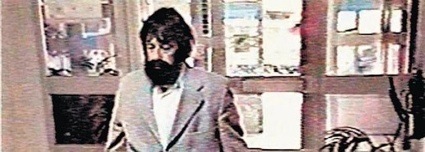 Jaime Giménez Arbe, alias “El Solitario”
Jaime Giménez Arbe, alias “El Solitario”
Nuría Güell graduated from the University of Barcelona with a degree in Fine Art and continued her studies under Tania Bruguera at the Behaviour Art School in Havana, Cuba. Güell has won several awards in Spain and her work has been exhibited in biennials, museums and galleries across the world. What makes her work particularly thought-provoking and relevant today is that she is an artist who doesn’t just stop at commenting on social injustice and unethical practices. Instead, she immerses herself into the mechanisms responsible for them and then turns them upside down in order to develop projects and alternative models that will foster a critical understanding and independent thinking of the public.
In 2009, the artist wanted to understand the ongoing recession and started studying monetary politics. The result of her research is the manual How to Expropriate Money from the Banks. It’s a guide packed with strategies, legal consultation and analytical texts that people can download for free and apply to their own life.
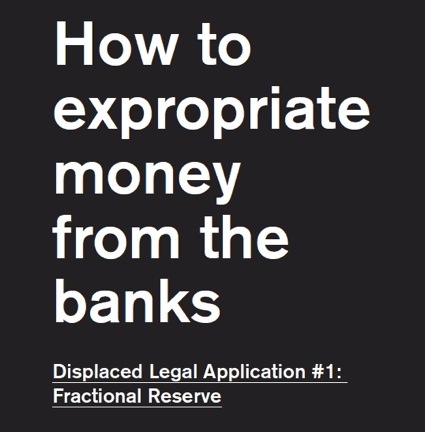
More recently, she worked with Jaime Giménez Arbe, a famous Spanish anarchist and bank robber known as El Solitario (“The Loner”) and convinced him to design the plan to rob a bank from the high security prison where he was detained. She sold the first chapter through an auction house and gave the money obtained to El Solitario.
For Deterrence, she teamed up with Enric Duran (an activist who, in 2008, cheated the banks out of 498.000 Euros he then used to finance projects that offered socially-conscious alternatives to capitalism) to teach high school students about the current financial system. That’s the kind of knowledge we are all in dire need of. Yet, the concept of money and what it entails is not part of any school curriculum (at least any that i know of.)
In Intervention # 1 the artist established a cooperative and used it to hire a construction worker who had lost his job and been evicted from his house. The objective of the contract was to remove the entrance doors to empty buildings that Caja Mediterráneo (CAM) had acquired at auction after evicting families who lived there. The contract signed through a legal entity ensured the impunity of the worker. Banks use a similar strategy to circumvent the Ley de Enjuiciamiento Civil (Civil Indictment Act) with impunity and purchase evicted properties for half of their valuation.
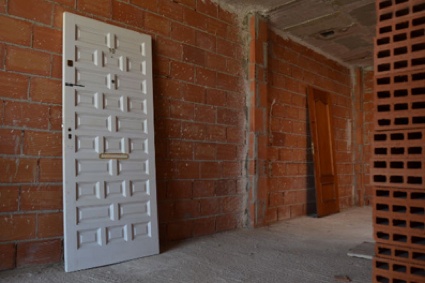 Intervention #1, Jaula de Oro, Alicante 2012
Intervention #1, Jaula de Oro, Alicante 2012
I could go on and on but check out her website if you’re curious about her projects. In the meantime, I’m very happy that Nuría has accepted to answer my questions for the blog. If you want to read her answers in spanish, i copy/pasted her original answers at the bottom of the post.
I’m amazed by all the information provided for the project Displaced Legal Application #1: Fractional Reserve: videos, conference, a detailed PDF on “How can we expropriate money to banks?”, etc. Are there lessons in this project that a citizen apply easily in their every day life?
Yes! This was the objective of the work which, in addition to functioning as a potential exercise for thinking, also functions as a resource for citizens to use. I want all my projects to propose a strategy that can be replicated. Sometimes it is implicit through the process of the work but in this case, being a manual, the idea that this is a resource for citizens is more explicit. There is a chapter entitled Step by Step, which details all the steps necessary for any citizen to expropriate banks. And if anyone has any questions, they can always write us, they won’t be the first to do so and we will be happy to advise them.
Check out the PDF: How to expropriate money from the banks.
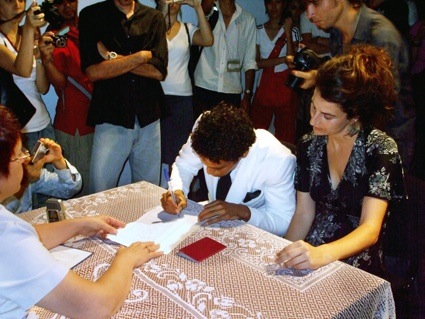 Ayuda humanitaria / Humanitarian help, 2009. Photo via art21
Ayuda humanitaria / Humanitarian help, 2009. Photo via art21
I actually learnt a lot while watching the videos on the project page. I learnt things that should be basic: what is money, how does a bank generate money, etc. So i would say that your work has had an impact on my own life. But more generally, what do you think is the role of an artist working on socially-engaged projects? Can they really have an influence on the issues they denounce/engage with?
I believe that we are at a critical moment, both historically and socio-politically, and that the role of the artist and the art should thus measure up to the situation, without being condescending. That’s why I want my projects to work on two levels: within the art context but also outside of it, since the transformation through art projects into something real interests me far more than the mere representation. My goal is that they function not only as resources for citizens but also as potential devices for thinking through the conceptual density. I’m not interested in representing political ideas but in offering opportunities for thinking and resources through the action, that can truly counter political systems (albeit on a micro level) or generate a counterweight.
The roles of art and the artist can be many, but for me, at this time of urgency, I think that political art is the one that holds a discursive struggle that manages to subvert the hegemonic discourse that subjects and oppresses us. Hence my interest in projects that have a life outside the art context, as I want to reach other segments of the population and not only the elite who visits art institutions.
The concept of operativity is important to me when working on projects that have a social dimension. And by that I do not mean operativity in the art project itself but an operativity that transcends art and the project and that it is effective for people who engaged with the work.
Yes, I think you can exert a real influence or transformation through art. I know of people who are expropriating banks by following the manual, my Cuban husband got his nationality by marrying me as a result of an art project (and we’re getting divorced!) and María, a political refugee from Kosovo who has been living illegally in Sweden for 9 years because the government has denied her asylum twice, will receive a work permit in a month thanks to a contract we did through a museum that hired her to play hide and seek with the visitors of the Göteborg biennial.
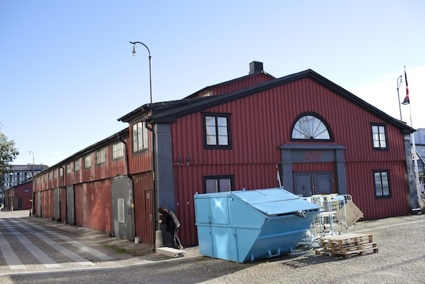 Too Much Melanin, Sweden, 2013. Image a-desk.com
Too Much Melanin, Sweden, 2013. Image a-desk.com
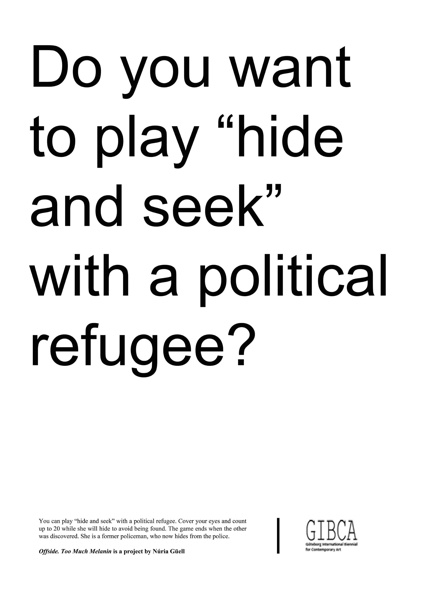 Poster for Too Much Melanin, Sweden, 2013
Poster for Too Much Melanin, Sweden, 2013
Also does the fact that you are an artist helps your projects? Because on the one hand, being an artist gives you certain liberties and ensures that you will reach a certain type of audience. On the other hand, the fact that you are ‘labelled’ as an artist might make you seem less serious, some people might dismiss some of your work because they are actually ‘only’ art projects.
Right. This is another feature of art that I use for projects: Autonomy. As we all know, throughout history, art has attempted to break free from the powers -religion, monarchy and politics- that wanted to use it for their own purposes. But as you say, this achieved autonomy makes art a more permissive space with the consequence that some people, as soon as they learn that it is an artistic project, refuse to consider it as a possible force that can have transformative effects on reality. What interests me is to instrumentalize this autonomy in favor of achieving the objectives of the projects. I call it using art as umbrella, in the sense of a ‘space of protection’. And I use it strategically to carry out certain alegalities which work for me as a significant resource. Somehow, I think there is also a less conscious desire to test the boundaries of art, if there’s any such thing.
For now, apart from a death threat, I never had any problems, although I am aware that there is a legal risk in all my projects and perhaps at some point the protection that art gives us with won’t be enough anymore.
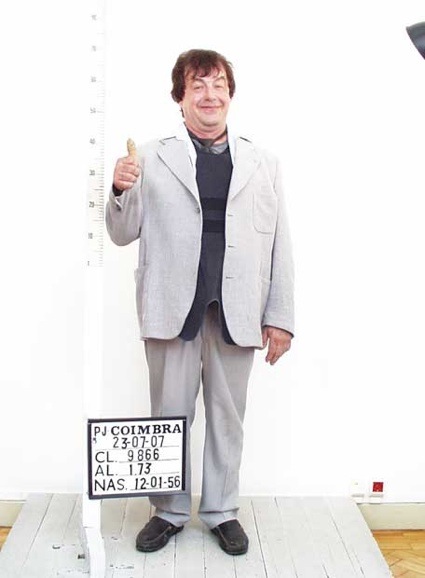 Jaime Giménez Arbe making mocking face at the police photos
Jaime Giménez Arbe making mocking face at the police photos
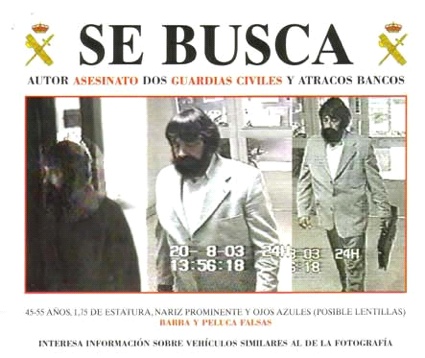 Wanted
Wanted
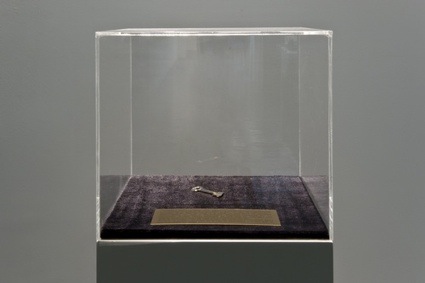 Displaced Moral Application # 1: Exponential Growth, 2010-2012 (photo Roberto Ruiz)
Displaced Moral Application # 1: Exponential Growth, 2010-2012 (photo Roberto Ruiz)
If i understood correctly Jaime Giménez Arbe was in a high security prison when you got in touch with him. How easy/difficult was it to communicate with him? Did you manage to actually meet him or did the whole project take place via letters? Phone or email conversations?
Yes, the fact that Jaime is locked in a high security prison has made the whole process of the project more complex, because many of the letters are intercepted by the guards. At first we communicated well through letters but at some point they cut our exchanges. The police put me on the blacklist and the letters that Jaime was sending me never arrived. Part of the information could get out of the jail with the help of the lawyer who visited Jaime, and the other part of the robbery plan was hidden within the letters that Jaime was sending to his family who later had it sent to me. Communicating via e-mail is impossible since prisoners are kept incommunicado and without access to the internet. After more than two years of correspondence, he was sometimes authorized to talk to me on the phone. Although it was always for a brief moment as they cut the call right away.
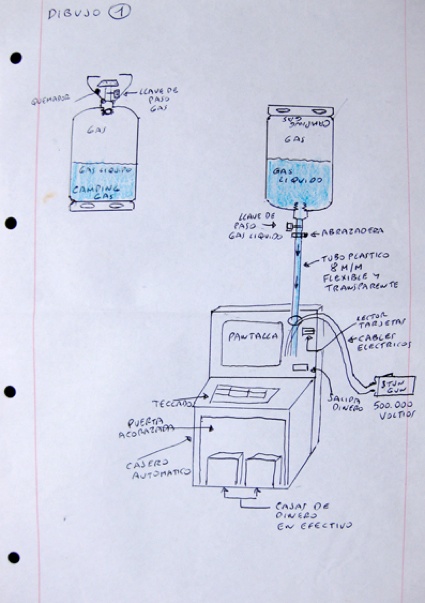 Drawing with the instructions to build a thermic lance included in the plan
Drawing with the instructions to build a thermic lance included in the plan
For your project, “El Solitario” wrote a book to describe various strategies to rob a bank. How could such a document get out of the prison? I always imagined there would censorship and that communicating such texts would be illegal in prison. Does the fact that this is an art project gave him more license?
In this case not even art could justify the content.
Something we had in our favor was that Jaime was writing in Spanish and Portuguese while prison guards were Portuguese wardens and therefore could not fully understand the contents of the letters and i was receiving most of the controversial information until they put me on the black list and our communication channels were cut.
For another project I’ve done with political prisoners in Spain it was indeed through “art” that we managed to get information about the systematic institutional torture to which prisoners living under the F.I.E.S.1 regime (Special tracking inmates file) are submitted.
Could you give more details about the result of the sale of the first chapter of the book at the auction house? Do you know who bought it and where the text is now?
What interested us the auction is that if someone bought the first chapter, it was because of the symbolic capital that the Spanish state itself and the police have given to Jaime with their criminalization campaigns that labelled him as “public enemy number one.” The first chapter was auctioned and the money went to Jaime.
I do not know who bought it, the auction house keeps the anonymity of their buyers.
What do you think were El Solitario’s motivations to participate in the art project?
I think Jaime had several motivations. First of all, I think, was the fact that I was already working on the project D. L. A. # 1: Fractional Reserve in collaboration with two anarchists appropriators of banks whom Jaime highly respects, that made him trust me.
On the other hand, there was an ideological affinity. In his letter of response to my proposal, he said he wanted to work on any project that exposes and visualizes banking ethics and the perverse strategies used by financial institutions to generate profits.
And finally, imagine living a life of total isolation and solitary confinement, perhaps having contact with someone from the outside will be like a window of air and light that somehow pierced through the walls of darkness within which he is confined.
Do you see many parallels between financial activity and the art business?
Yes, I see parallels with the art business. In both cases what matters is profitability, and by that I mean the creation of value out of a potential value, a key strategy in the inflation that both banking and speculation in the art business are based on. The objective in both cases is to generate maximum profit, often without regard to cultural, social and / or human values.
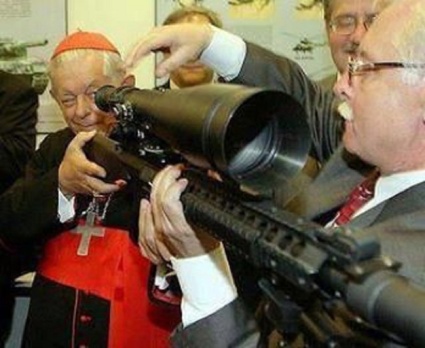 Cardinal testing a Pietro Beretta Ltd’s weapon, one of the major arms manufacturing companies in the world, the Vatican Bank (IOR) is its largest shareholder
Cardinal testing a Pietro Beretta Ltd’s weapon, one of the major arms manufacturing companies in the world, the Vatican Bank (IOR) is its largest shareholder
I’m also very curious about one of your work in progress APLICACIÓN MORAL DESPLAZADA #2: AD PIAS CAUSAS. Can you already tell us what the project will be about?
One day before the “International Day for the cessation of weapons”, I stole some hosts from the parish church of my town preventing the Priest to give the Holy sacrament to the parishioners and avoiding the collection of funds for the Holly Roman Apostolic Church. I was interested in commercialising the hosts in the art market.
With the profits from this action my intention is to order an hypothetical practical plan to commit an outrage against the Vatican Bank which is the first investor of one of the major weapons world companies. The aim of the plan is to expropriate the Bank’s goods and it will be design using all the weapons that the Bank finances.
The Holly Roman Apostolic Church is the authority symbol by excellence and one of the most influential powers in the world on a political level. Its major wealth is sustained by the commitment of the faithful even thought in a political level this is backed up by all the material wealth of which the Church is the owner. As a result of the two concept of “guilt” and “sin” that have been perpetuated along the centuries, the Church has increased its earnings through the selling of the forgiveness. Throughout its history, the Church has destroyed, slavered and pillaged entire communities with the pretext of the evangelisation, helping Nazi war criminals to find refuge in foreign countries in order to escape international justice, covering sexual abuses among the priest community in the media and funding terrorism from the investments done by their financial institution.
The I.O.R. (Vatican Bank) benefits from the privileges of the Vatican Bank to move money around the world avoiding international laws and working as a tax haven. It is located in the tower of Niccolò V inside the city of the Vatican and it is a bunker that keeps cash money, golden ingots, goods, as well as art works stolen by the Third Reich and offered to the Church. Currently, it is the major shareholder of Pietro Beretta Ltd, one of the major companies producing weapons of the world.
Paradoxically the I.O.R. justifies all its actions under the concept of “ad pías causas”, that is to mean by the religious qualities: its compassion and mercy.
Thanks Nuría!
———————
Answers in Spanish (the last question was answered directly in english):
I’m amazed by all the information provided for the project Displaced Legal Application #1: Fractional Reserve: videos, conference, a detailed PDF on “How can we expropriate money to banks?”, etc. Are there lessons in this project that a citizen apply easily in their every day life?
Sí! Esta era la idea de la obra, que además de funcionar como un potencial dispositivo de pensamiento funcione también como recurso para que los ciudadanos lo puedan usar. En todos mis proyectos me interesa que haya una estrategia que sea replicable, a veces está de manera implícita a través de la operación de la obra pero en este caso, al ser un manual, es más explícita la idea del recurso ciudadano. Hay un capítulo titulado Step by Step, que relata todos los pasos para que cualquier ciudadano pueda expropiar bancos. Y si alguien tiene alguna duda, que nos escriba que no será el primero que lo hace y para nosotros será un placer asesorarle.
PDF: Cómo expropiar dinero a entidades bancarias.
I actually learnt a lot while watching the videos on the project page. I learnt things that should be basic: what is money, how does a bank generate money, etc. So i would say that your work has had an impact on my own life. But more generally, what do you think is the role of an artist working on socially-engaged projects? Can they really have an influence on the issues they denounce/engage with?
Considero que estamos en un momento histórico y socio-político crítico y que por tanto el rol del artista y del arte debe estar a la altura del mismo, sin ser condescendiente. Por eso intento que todos los proyectos funcionen a dos niveles: dentro del contexto arte y fuera del mismo, ya que más que la representación lo que me interesa es la transformación en lo real que se puede llevar a cabo a través de los proyectos artísticos. Mi objetivo es que además de como recursos ciudadanos funcionen como potenciales dispositivos de pensamiento a través de la densidad conceptual. No me interesa representar ideas políticas sino ofrecer posibilidades de pensamiento y recursos a través de la acción, que realmente puedan contrarrestar sistemas políticos (aunque a nivel micro) o generar contrapoder.
El rol del arte y del artista pueden ser muchos, pero para mí, en este momento de urgencia, creo que el arte político es el que lleva a cabo una lucha discursiva que logra subvertir el discurso hegemónico que nos sujeta y oprime. De aquí mi interés en que los proyectos también vivan fuera del contexto artístico, ya que me interesa llegar a otras esferas de la población que no son solo las elites que frecuentan las instituciones artísticas.
El concepto de operatividad para mi es importante en los proyectos de carácter social, pero no me refiero a operatividad dentro del proyecto artístico sino de una operatividad que transcienda al arte y al proyecto y que sea efectiva para las personas qué con el proyecto se han relacionado. Sí creo que se puede ejercer una influencia o transformación real a través del arte. Sé de gente que está expropiando bancos a través de seguir el manual, mi esposo cubano obtuvo su nacionalidad a través de casarnos a raíz de un proyecto artístico (ya nos estamos divorciando!) y María, una refugiada política de Kosovo que lleva 9 años viviendo en Suecia de manera ilegal porque el Gobierno le han denegado el asilo dos veces, en un mes ya tendrá permiso de trabajo en Suecia gracias al contrato que le hicimos a través del museo para que jugara al escondite con los espectadores de la bienal.
Also does the fact that you are an artist helps your projects? Because on the one hand, being an artist gives you certain liberties and ensures that you will reach a certain type of audience. On the other hand, the fact that you are ‘labelled’ as an artist might make you seem less serious, some people might dismiss some of your work because they are actually ‘only’ art projects.
Exacto. Esta es otra de las características del arte que utilizo a favor de los proyectos: La autonomía. Como todos sabemos a lo largo de la Historia el Arte ha tratado de liberarse de los poderes que lo querían usar para sus fines, como fue la religión, la monarquía y la política. Pero como tú bien dices, esta autonomía lograda hace que el arte sea un espacio más permisivo, hasta el punto de que alguna gente al saber que es un proyecto artístico lo desacredita como posible potencia transformadora de efectos en lo real. A mí lo que me interesa es instrumentalizar esta autonomía a favor de lograr los objetivos de los proyectos. Yo lo llamo usar el Arte como paraguas, refiriéndome a un espacio de protección. Y lo uso de manera estratégica para llevar a cabo ciertas alegalidades que me funcionan como recurso significativo. De alguna manera no tan consciente creo que también hay una voluntad de testar lo limites del Arte, si es que tiene.
De momento, más allá de una amenaza de muerte, no he tenido ningún problema, aunque soy consciente que en todos los proyectos hay riesgo a nivel legal y que quizás en algún momento la protección que nos brinda el Arte no sea suficiente.
If i understood correctly Jaime Giménez was in a high security prison when you got in touch with him. How easy/difficult was it to communicate with him? Did you manage to actually meet him or did the whole project take place via letters? Phone or email conversations?
Sí, el hecho de que Jaime esté encerrado en una prisión de alta seguridad ha complejizado todo el proceso del proyecto, ya que muchas de las cartas son interceptadas por los carceleros. Al principio nos comunicábamos bien a través de las cartas pero llegó un momento que nos cortaron la comunicación. La policía me puso en la lista negra y las cartas que Jaime me enviaba a mí nunca me llegaban. Parte de la información la pudimos sacar de la cárcel gracias a la abogada que visitaba a Jaime, y la otra parte del plan de atraco Jaime lo camuflaba dentro de las cartas que él enviaba a su familia y después ellos me las hacían llegar a mí. Comunicarnos vía e-mail es imposible ya que los tienen incomunicados y sin acceso a internet.
Después de más de 2 años de correspondencia, alguna vez le han autorizado permiso para que pudiésemos hablar por teléfono. Aunque siempre ha sido bien breve ya que enseguida cortan la llamada.
For your project, “El Solitario” wrote a book to describe various strategies to rob a bank. How could such a document get out of the prison? I always imagined there would censorship and that communicating such texts would be illegal in prison. Does the fact that this is an art project gave him more license?
En este caso ni el Arte pudo justificar los contenidos.
Algo que teníamos a nuestro favor era que Jaime escribía en español y que los carceleros eran portugueses, por lo tanto no entendían completamente el contenido de las cartas y mucha información controversial me llegó hasta el momento que me pusieron en la lista negra y nos cortaron la comunicación.
En otro proyecto que he realizado con presos políticos en España sí que fue a través del “Arte” que logramos sacar información sobre la tortura institucional sistemática a la que están sometidos los presos FIES1.
Could you give more details about the result of the sale of the first chapter of the book at the auction house? Do you know who bought it and where the text is now?
Lo que nos interesaba de la subasta es que si alguien adquiría el primer capítulo era debido al capital simbólico que el propio Estado español y la policía han otorgado a Jaime con las campañas de criminalización a su persona tachándolo de “enemigo público número uno”. El primer capítulo se subastó y el dinero fue para Jaime.
No lo sé, la casa de subastas guarda el anonimato de sus compradores.
What do you think were El Solitario’s motivations to participate in the art project?
Creo que la motivación de Jaime fue por diversos motivos. Primero de todo creo que el hecho de que yo ya estuviera realizando el proyecto D. L. A. #1: Fractional Reserve en el que colaboraban dos anarquistas expropiadores de bancos a los que Jaime respeta mucho, a él le dio cierta confianza.
Por otro lado había una afinidad ideológica, en su carta de respuesta a mi proposición me dijo que quería colaborar en cualquier proyecto que denunciara y visibilizara la ética bancaria y las perversas estrategias que usan las entidades financieras para generar beneficios.
Y por último, imagino que viviendo en un régimen de vida de aislamiento total e incomunicación, quizás el hecho de tener contacto por carta con alguien del exterior debe ser como una ventana de aire y luz que de alguna manera agrieta los muros de la oscuridad a la que está condenado.
Do you see many parallels between financial activity and the art business?
Sí, con el negocio del Arte sí veo paralelismos. En los dos casos lo más importante es la rentabilidad, ósea generar valor de un valor potencial, estrategia clave dentro de la inflación en la que se basa la banca y la especulación del negocio artístico. El objetivo en ambos casos es generar los máximos beneficios, en muchas ocasiones sin tener en cuenta valores culturales, sociales y/o humanos.
I’m also very curious about one of your work in progress “APLICACIÓN MORAL DESPLAZADA #2: AD PIAS CAUSAS”. Can you already tell us what the project will be about?
One day before the “International Day for the cession of weapons”, I stole some hosts from the parish church of my town unabling the Priest to give the Holy sacrament to the parishioners and avoiding the collection of funds for the Holly Roman Apostolic Church. I was interested in commercialising the hosts in the art market.
With the profits from this action my intention is to order an hypothetical practical plan to commit an outrage against the Vatican Bank which is the first investor of one of the major weapons world companies. The aim of the plan is to expropriate the Bank’s goods and it will be design using all the weapons that the Bank finances.
The Holly Roman Apostolic Church is the authority symbol by excellence and one of the most influential powers in the world in a political level. Its major wealth is sustained by the commitment of the faithful even thought in a political level this is backed up by all the material wealth of which the Church is the owner. As a
result of the two concept of “guilt” and “sin” that have been perpetuated along the centuries, the Church has increased its earnings through the selling of the forgiveness. Throughout its history, the Church has destroyed, slavered and pillaged entire communities with the pretext of the evangelisation, helping Nazi war criminals to find refuge in foreign countries in order to escape international justice, covering sexual abuses among the priest community in the media and funding terrorism from the investments done by their financial institution.
The I.O.R. (Vatican Bank) benefits from the privileges of the Vatican Bank to move money around the world avoiding international laws and working as a tax haven. It is located in the Torreón of Niccolo V inside the city of the Vatican and it is a bunker that keeps: cash money, golden ingots, goods, as well as art works stolen by
the Third Reich and offered to the Church. Currently, it is the major shareholder of Pietro Beretta Ltd, one of the major companies producing weapons of the world.
Paradoxically the I.O.R. justifies all its actions under the concept of “ad pías causas”, that is to mean by the religious qualities: its compassion and mercy.
